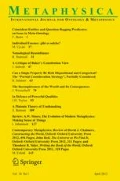Abstract
Aristotle’s theory of physical objects, hylomorphism, has resurfaced in contemporary metaphysics. In its current version, hylomorphism is proposed as a general theory of mereology, its purview extending beyond material objects to chemical composites, events, and non-physical mathematical, linguistic, and musical objects. While I agree that hylomorphism works well in all of the newly proposed applications, it fails as a theory of properties and their parts. I show that this is the case and then theorize about why this is so.
Similar content being viewed by others
Notes
Johnston (2006) makes a distinction between genuine objects, groups, and mere collections or sets.
Fine 2006.
This example originated with Kit Fine (2006) and is repeated by Johnston.
David S. Oderberg (2007).
I hold it as true that properties exist as abstractions and that they are instantiated in particular patches of physical space. The point about properties and their parts is really about their instantiated instances.
Color is complex and probably is not best thought of as a property in physical space, but a product of interaction with light, surface, and visual system, but the added complexity does not matter here. All we need is that whatever color is, it will be the same physical location eye/object or event as hue.
I use the words “instantiated” but I do not think what I say here even commits me to the idea that properties are abstractions which are instantiated in the physical. These points here are equally applicable to a trope view of properties. If we deny that properties are universals or abstractions, then what I say applies only to the particulars, be they abstract or concrete.
There is a skeptical objection to the idea that these kinds of physical formulae are genuine part/whole relationships to begin with. One might deny that there is any truth of the matter to which formula expressed the correct part/whole relationship. Since a whole cannot be a part of its part, this position would be tantamount to denying that these kinds of formulas are mereological relationships at all and that part and whole are misapplied here. The part/whole relationship is not asymmetric and so mass is not a part of density; neither is density a part of mass. Nevertheless, if we wanted to maintain that there is a fact of the matter on which are parts and which wholes, we would not invoke organizing principles, but rather a foundationalism about parts.
And mirroring the logical relationships that we require of parts and wholes, dominance relations are irreflexive, transitive, and asymmetric. I wish to thank Brian Beakley for explaining this linguistic relationship as an especially good example of an organizing principle for abstract objects.
References
Fine, Kit (2006) “In Defense of Three-Dimensionalism” Journal of Philosophy Vol 103, No. 12
Johnston, Mark (2006) “Hylomorphism” Journal of Philosophy Vol 103, No. 12
Koslicki, Kathrin. The Structure of Objects, (2008) Oxford University Press, Oxford
Oderberg, David. Real Essentialism, (2007) Routledge Press, London
Author information
Authors and Affiliations
Corresponding author
About this article
Cite this article
Britton, T. The Limits of Hylomorphism. Int Ontology Metaphysics 13, 145–153 (2012). https://doi.org/10.1007/s12133-012-0099-5
Published:
Issue Date:
DOI: https://doi.org/10.1007/s12133-012-0099-5



